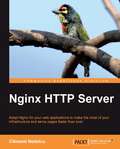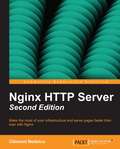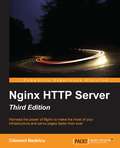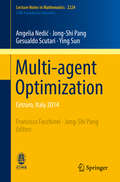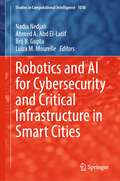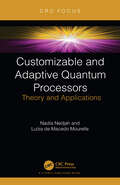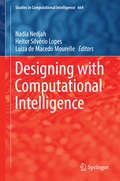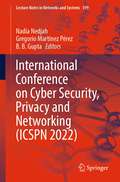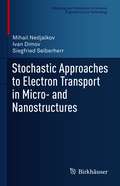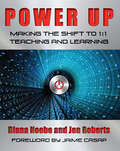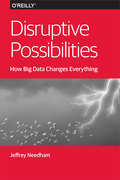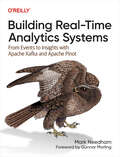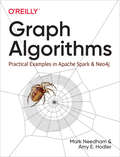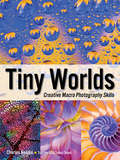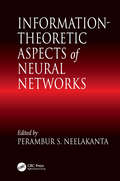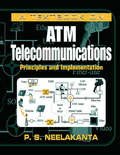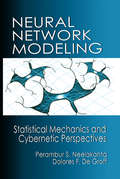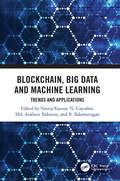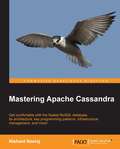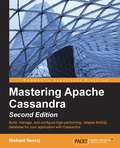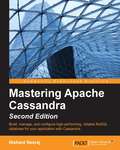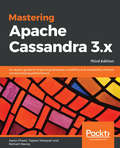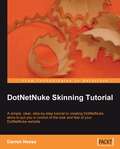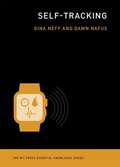- Table View
- List View
Nginx HTTP Server
by Clement NedelcuThe book includes detailed instructions for each of the processes it describes: downloading and installing the application, configuring and using modules, and much more. It provides a step-by-step tutorial to replace your existing web server with Nginx. With commented configuration sections and in-depth module descriptions, you will be able to make the most of the performance potential offered by Nginx. By covering both early setup stages and advanced topics, this book will suit web administrators interested in solutions to optimize their infrastructure, whether they are looking into replacing existing web server software or integrating a new tool cooperating with applications already up and running. If you, your visitors, and your operating system have been disappointed by Apache, this book is exactly what you need.
Nginx HTTP Server Second Edition
by Clement NedelcuThis tutorial book includes detailed instructions for each of the processes it describes: downloading and installing the application, configuring and using modules, and much more. It provides a step-by-step tutorial to replace your existing web server with Nginx. With commented configuration sections and in-depth module descriptions, you will be able to make the most of the performance potential offered by Nginx.By covering both early setup stages and advanced topics this book will suit web administrators interested in solutions to optimize their infrastructure, whether they are looking into replacing existing web server software or integrating a new tool cooperating with applications already up and running. If you, your visitors and your operating system have been disappointed by Apache, this book is exactly what you need.
Nginx HTTP Server - Third Edition
by Clement NedelcuHarness the power of Nginx to make the most of your infrastructure and serve pages faster than ever About This Book * Discover possible interactions between Nginx and Apache to get the best of both worlds * Learn to exploit the features offered by NGinx for your web applications * Get the newest techniques available, designed with the latest version in mind Who This Book Is For By covering both the early setup stages and advanced topics, this book suits web administrators who interested in solutions to optimize their infrastructure, whether you are looking into replacing your existing web server software or integrating a new tool to cooperate with applications that are already up and running. If you, your visitors, and your operating system have been disappointed by Apache, this book is exactly what you need. What You Will Learn * Get to know the basics of the Nginx configuration: syntax, structure, and semantics * Understand the advanced load balancing functionality of Nginx and the newest innovative IO mechanisms * Create virtual host configurations effortlessly * Discover all the first-party modules: how to enable, configure, and use them * Establish advanced rewrite rules with the Nginx Rewrite module * Set up Nginx to work with PHP, Python, and more via FastCGI * Configure Nginx to work as frontend for your existing HTTP server * Manipulate configuration files with ease and adapt them to various situations * Discover the common pitfalls and find out how to avoid them In Detail Nginx is a lightweight HTTP server designed for high-traffic websites, with network scalability as the primary objective. With the advent of high speed Internet access, short loading times and fast transfer rates have become a necessity. This free, open source solution will either come as a full replacement of other software such as Apache, or stand in front of your existing infrastructure to improve its overall speed. This book is a detailed guide to setting up Nginx in different ways that correspond to actual production situations: as a standalone server, as a reverse proxy, interacting with applications via FastCGI, and more. In addition, this complete directive reference will be your best friend at all stages of the configuration and maintenance processes. This book is the perfect companion for both Nginx beginners and experienced administrators. For beginners, it will take you through the complete process of setting up this lightweight HTTP server on your system and configuring its various modules so it does exactly what you need quickly and securely. For more experienced administrators, this book provides different approaches that can help you make the most of your current infrastructure. Nginx can be employed in many situations, whether you are looking to construct an entirely new web-serving architecture or simply want to integrate an efficient tool to optimize your site loading speeds. Style and approach This tutorial-style book includes detailed instructions on each of the processes it describes, as well as step-by-step tutorials, commented configuration sections, and in-depth module descriptions, so you can make the most of the performance potential offered by Nginx.
Multi-agent Optimization: Cetraro, Italy 2014 (Lecture Notes in Mathematics #2224)
by Angelia Nedić Jong-Shi Pang Gesualdo Scutari Ying Sun Francisco FacchineiThis book contains three well-written research tutorials that inform the graduate reader about the forefront of current research in multi-agent optimization. These tutorials cover topics that have not yet found their way in standard books and offer the reader the unique opportunity to be guided by major researchers in the respective fields. Multi-agent optimization, lying at the intersection of classical optimization, game theory, and variational inequality theory, is at the forefront of modern optimization and has recently undergone a dramatic development. It seems timely to provide an overview that describes in detail ongoing research and important trends. This book concentrates on Distributed Optimization over Networks; Differential Variational Inequalities; and Advanced Decomposition Algorithms for Multi-agent Systems. This book will appeal to both mathematicians and mathematically oriented engineers and will be the source of inspiration for PhD students and researchers.
Robotics and AI for Cybersecurity and Critical Infrastructure in Smart Cities (Studies in Computational Intelligence #1030)
by Nadia Nedjah Ahmed A. Abd El-Latif Brij B. Gupta Luiza M. MourelleThis book bridges principles and real-world applications, while also providing thorough theory and technology for the development of artificial intelligence and robots. A lack of cross-pollination between AI and robotics research has led to a lack of progress in both fields. Now that both technologies have made significant strides, there is increased interest in combining the two domains in order to create a new integrated AI and robotics trend. In order to achieve wiser urbanization and more sustainable development, AI in smart cities will play a significant part in equipping the cities with advanced features that will allow residents to safely move about, stroll, shop, and enjoy a more comfortable way of life. If you are a student, researcher, engineer, or professional working in this field, or if you are just curious in the newest advancements in robotics and artificial intelligence for cybersecurity, this book is for you!
Customizable and Adaptive Quantum Processors: Theory and Applications
by Nadia Nedjah Luiza De Macedo MourelleThe book describes state-of-the-art advances in simulators and emulators for quantum computing. It introduces the main concepts of quantum computing, defining q-bits, explaining the parallelism behind any quantum computation, describing measurement of the quantum state of information and explaining the process of quantum bit entanglement, collapsed state and cloning. The book reviews the concept of quantum unitary, binary and ternary quantum operators as well as the computation implied by each operator. It provides details of the quantum processor, providing its architecture, which is validated via execution simulation of some quantum instructions.
Designing with Computational Intelligence
by Nadia Nedjah Heitor Silvério Lopes Luiza de Macedo MourelleThis book discusses a number of real-world applications of computational intelligence approaches. Using various examples, it demonstrates that computational intelligence has become a consolidated methodology for automatically creating new competitive solutions to complex real-world problems. It also presents a concise and efficient synthesis of different systems using computationally intelligent techniques.
International Conference on Cyber Security, Privacy and Networking (Lecture Notes in Networks and Systems #599)
by Nadia Nedjah Gregorio Martínez Pérez B. B. GuptaThis book covers selected high-quality research papers presented in the International Conference on Cyber Security, Privacy and Networking (ICSPN 2022), organized during September 09–11, 2022, in Thailand in online mode. The objective of ICSPN 2022 is to provide a premier international platform for deliberations on strategies, recent trends, innovative approaches, discussions and presentations on the most recent cyber security, privacy and networking challenges and developments from the perspective of providing security awareness and its best practices for the real world. Moreover, the motivation to organize this conference is to promote research by sharing innovative ideas among all levels of the scientific community and to provide opportunities to develop creative solutions to various security, privacy and networking problems.
Stochastic Approaches to Electron Transport in Micro- and Nanostructures (Modeling and Simulation in Science, Engineering and Technology)
by Mihail Nedjalkov Ivan Dimov Siegfried SelberherrThe book serves as a synergistic link between the development of mathematical models and the emergence of stochastic (Monte Carlo) methods applied for the simulation of current transport in electronic devices. Regarding the models, the historical evolution path, beginning from the classical charge carrier transport models for microelectronics to current quantum-based nanoelectronics, is explicatively followed. Accordingly, the solution methods are elucidated from the early phenomenological single particle algorithms applicable for stationary homogeneous physical conditions up to the complex algorithms required for quantum transport, based on particle generation and annihilation. The book fills the gap between monographs focusing on the development of the theory and the physical aspects of models, their application, and their solution methods and monographs dealing with the purely theoretical approaches for finding stochastic solutions of Fredholm integral equations.
Power Up: Making the Shift to 1:1 Teaching and Learning
by Diana Neebe Jen RobertsWherever you are on the path to 1:1 teaching and learning, you need a guide that can help you make the best use of the powerful technology available in today's classrooms. In Power Up: Making the Shift to 1:1 Teaching and Learning, Diana Neebe and Jen Roberts draw on research and their extensive experience working with teachers across subject areas and grade levels to share the keys to success when teaching with a computer or tablet for every student. This is the book secondary teachers need to understand the changes in pedagogy, planning, classroom organization, time management, and collaboration that will help them be successful in a 1:1 environment. Whether providing immediate and detailed feedback to student writers, giving voice to quiet learners, or creating more time for actual work in a jam-packed school day, Neebe and Roberts show teachers how communication, differentiation, and other effective practices can be powered up with personalized technology. Throughout the book, Neebe and Roberts coach teachers through their initial concerns about technology integration, offer advice about avoiding common problems, and encourage innovation. Using detailed classroom examples, questions, and suggestions, they provide a framework for shaping the transformation of a traditional classroom into a student-centered, technology-rich learning environment. Readers will come away with a clear sense of how a fully implemented 1:1 classroom operates. Power Up makes the transition to 1:1 a manageable and exciting journey. It's a key part of supporting teachers and ensuring the success of your 1:1 program.
Disruptive Possibilities: How Big Data Changes Everything
by Jeffrey NeedhamIn Disruptive Possibilities: How Big Data Changes Everything i>, Jeff enlightens Fortune 500 enterprises about the Big Data ecosystem as they begin to channel their data from stranded silos into an accessible reservoir of possibility and discovery. Jeff explains where commercial supercomputing came from, where it is and its impact on the future of computing.
Building Real-Time Analytics Systems
by Mark NeedhamGain deep insight into real-time analytics, including the features of these systems and the problems they solve. With this practical book, data engineers at organizations that use event-processing systems such as Kafka, Google Pub/Sub, and AWS Kinesis will learn how to analyze data streams in real time. The faster you derive insights, the quicker you can spot changes in your business and act accordingly.Author Mark Needham from StarTree provides an overview of the real-time analytics space and an understanding of what goes into building real-time applications. The book's second part offers a series of hands-on tutorials that show you how to combine multiple software products to build real-time analytics applications for an imaginary pizza delivery service.You will:Learn common architectures for real-time analyticsDiscover how event processing differs from real-time analyticsIngest event data from Apache Kafka into Apache PinotCombine event streams with OLTP data using Debezium and Kafka StreamsWrite real-time queries against event data stored in Apache PinotBuild a real-time dashboard and order tracking appLearn how Uber, Stripe, and Just Eat use real-time analytics
Graph Algorithms: Practical Examples in Apache Spark and Neo4j
by Mark Needham Amy E. HodlerDiscover how graph algorithms can help you leverage the relationships within your data to develop more intelligent solutions and enhance your machine learning models. You’ll learn how graph analytics are uniquely suited to unfold complex structures and reveal difficult-to-find patterns lurking in your data. Whether you are trying to build dynamic network models or forecast real-world behavior, this book illustrates how graph algorithms deliver value—from finding vulnerabilities and bottlenecks to detecting communities and improving machine learning predictions.This practical book walks you through hands-on examples of how to use graph algorithms in Apache Spark and Neo4j—two of the most common choices for graph analytics. Also included: sample code and tips for over 20 practical graph algorithms that cover optimal pathfinding, importance through centrality, and community detection.Learn how graph analytics vary from conventional statistical analysisUnderstand how classic graph algorithms work, and how they are appliedGet guidance on which algorithms to use for different types of questionsExplore algorithm examples with working code and sample datasets from Spark and Neo4jSee how connected feature extraction can increase machine learning accuracy and precisionWalk through creating an ML workflow for link prediction combining Neo4j and Spark
Tiny Worlds
by Charles NeedleSuccessful nature photographer and lecturer Charles Needle often asks students in his workshops if they understand the difference between "looking" and "seeing". The difference he is pointing out is that while we are constantly "looking" at countless people, places and things, we might not be actually seeing what is right in front of us. Being tuned into this difference can elevate your art as a photographer, allowing you to be more in tune with your surroundings. Needle has applied this concept to his work and it shows. Utilizing macro photography to capture the nuances of the nature all around us. In this extensive handbook, Needle covers not only his philosophy for seeing and capturing nature photography but delves into the equipment he uses. Needle covers composition, flash techniques, the fundamentals of macro photography and so much more. The book features many set-up shots, equipment shots and sequential shots detailing the progression towards creating the final images. This essential text provides both the inspiration and the technique required to beautifully capture the wonders of nature.
Information-Theoretic Aspects of Neural Networks
by P. S. NeelakantaInformation theoretics vis-a-vis neural networks generally embodies parametric entities and conceptual bases pertinent to memory considerations and information storage, information-theoretic based cost-functions, and neurocybernetics and self-organization. Existing studies only sparsely cover the entropy and/or cybernetic aspects of neural information.Information-Theoretic Aspects of Neural Networks cohesively explores this burgeoning discipline, covering topics such as:Shannon information and information dynamicsneural complexity as an information processing systemmemory and information storage in the interconnected neural webextremum (maximum and minimum) information entropyneural network trainingnon-conventional, statistical distance-measures for neural network optimizationssymmetric and asymmetric characteristics of information-theoretic error-metricsalgorithmic complexity based representation of neural information-theoretic parametersgenetic algorithms versus neural informationdynamics of neurocybernetics viewed in the information-theoretic planenonlinear, information-theoretic transfer function of the neural cellular unitsstatistical mechanics, neural networks, and information theorysemiotic framework of neural information processing and neural information flowfuzzy information and neural networksneural dynamics conceived through fuzzy information parametersneural information flow dynamicsinformatics of neural stochastic resonanceInformation-Theoretic Aspects of Neural Networks acts as an exceptional resource for engineers, scientists, and computer scientists working in the field of artificial neural networks as well as biologists applying the concepts of communication theory and protocols to the functioning of the brain. The information in this book explores new avenues in the field and creates a common platform for analyzing the neural complex as well as artificial neural networks.
A Textbook on ATM Telecommunications: Principles and Implementation
by P. S. NeelakantaWith quantum leaps in science and technology occurring at breakneck speed, professionals in virtually every field face a daunting task-practicing their discipline while keeping abreast of new advances and applications in their filed. In no field is this more applicable than in the rapidly growing field of telecommunications engineering. Practicing engineers who work with ATM technology on a daily basis must not only keep their skill sharp in areas such as ATM network interfaces, protocols, and standards, but they must also stay informed, about new classes of ATM applications.A Textbook on ATM Telecommunications gives active telecommunications engineers the advantage they need to stay sharp in their field. From the very basics of ATM to state-of-the-art applications, it covers the gamut of topics related to this intriguing switching and multiplexing strategy. Starting with an introduction to telecommunications, this text combines the theory underlying broadband communications technology with applied practical instruction and lessons gleaned from industry. The author covers fundamental communications and network theory, followed by applied ATM networking. Each chapter includes design exercises as well as worked examples .A Textbook on ATM Telecommunications includes examples of design and implementation-making it an ideal took for both aspiring and practicing telecommunication professionals.Features
Neural Network Modeling: Statistical Mechanics and Cybernetic Perspectives
by P. S. Neelakanta Dolores DeGroffNeural Network Modeling offers a cohesive approach to the statistical mechanics and principles of cybernetics as a basis for neural network modeling. It brings together neurobiologists and the engineers who design intelligent automata to understand the physics of collective behavior pertinent to neural elements and the self-control aspects of neurocybernetics. The theoretical perspectives and explanatory projections portray the most current information in the field, some of which counters certain conventional concepts in the visualization of neuronal interactions.
Blockchain, Big Data and Machine Learning: Trends and Applications
by Neeraj Kumar; N. Gayathri; Md. Arafatur Rahman; B. BalamuruganPresent book covers new paradigms in Blockchain, Big Data and Machine Learning concepts including applications and case studies. It explains dead fusion in realizing the privacy and security of blockchain based data analytic environment. Recent research of security based on big data, blockchain and machine learning has been explained through actual work by practitioners and researchers, including their technical evaluation and comparison with existing technologies. The theoretical background and experimental case studies related to real-time environment are covered as well. Aimed at Senior undergraduate students, researchers and professionals in computer science and engineering and electrical engineering, this book: Converges Blockchain, Big Data and Machine learning in one volume. Connects Blockchain technologies with the data centric applications such Big data and E-Health. Easy to understand examples on how to create your own blockchain supported by case studies of blockchain in different industries. Covers big data analytics examples using R. Includes lllustrative examples in python for blockchain creation.
Mastering Apache Cassandra
by Nishant NeerajMastering Apache Cassandra is a practical, hands-on guide with step-by-step instructions. The smooth and easy tutorial approach focuses on showing people how to utilize Cassandra to its full potential.This book is aimed at intermediate Cassandra users. It is best suited for startups where developers have to wear multiple hats: programmer, DevOps, release manager, convincing clients, and handling failures. No prior knowledge of Cassandra is required.
Mastering Apache Cassandra - Second Edition
by Nishant NeerajThe book is aimed at intermediate developers with an understanding of core database concepts who want to become a master at implementing Cassandra for their application.
Mastering Apache Cassandra Second Edition
by Nishant Neeraj<P><P>Build, manage, and configure high-performing, reliable NoSQL database for your application with Cassandra <P><P>About This Book <P><P>Develop applications for modelling data with Cassandra 2 <P><P>Manage large amounts of structured, semi-structured, and unstructured data with Cassandra <P><P>Explore a wide-range of Cassandra components and how they interact to create a robust, distributed system. <P><P>Who This Book Is For <P><P>The book is aimed at intermediate developers with an understanding of core database concepts who want to become a master at implementing Cassandra for their application. <P><P>What You Will Learn <P><P>Write programs using Cassandra's features more efficiently <P><P>Get the most out of a given infrastructure, improve performance, and tweak JVM <P><P>Use CQL3 in your application, which makes working with Cassandra more simple <P><P>Configure Cassandra and fine-tune its parameters depending on your needs <P><P>Set up a cluster and learn how to scale it <P><P>Monitor Cassandra cluster in different ways <P><P>Use Hadoop and other big data processing tools with Cassandra <P><P>In Detail <P><P>With ever increasing rates of data creation comes the demand to store data as fast and reliably as possible, a demand met by modern databases such as Cassandra. Apache Cassandra is the perfect choice for building fault tolerant and scalable databases. Through this practical guide, you will program pragmatically and understand completely the power of Cassandra. Starting with a brief recap of the basics to get everyone up and running, you will move on to deploy and monitor a production setup, dive under the hood, and optimize and integrate it with other software. <P><P>You will explore the integration and interaction of Cassandra components, and explore great new features such as CQL3, vnodes, lightweight transactions, and triggers. Finally, by learning Hadoop and Pig, you will be able to analyze your big data.
Mastering Apache Cassandra 3.x: An expert guide to improving database scalability and availability without compromising performance, 3rd Edition
by Nishant Neeraj Aaron Ploetz Tejaswi MalepatiBuild, manage, and configure high-performing, reliable NoSQL database for your applications with CassandraKey FeaturesWrite programs more efficiently using Cassandra's features with the help of examplesConfigure Cassandra and fine-tune its parameters depending on your needsIntegrate Cassandra database with Apache Spark and build strong data analytics pipelineBook DescriptionWith ever-increasing rates of data creation, the demand for storing data fast and reliably becomes a need. Apache Cassandra is the perfect choice for building fault-tolerant and scalable databases. Mastering Apache Cassandra 3.x teaches you how to build and architect your clusters, configure and work with your nodes, and program in a high-throughput environment, helping you understand the power of Cassandra as per the new features.Once you’ve covered a brief recap of the basics, you’ll move on to deploying and monitoring a production setup and optimizing and integrating it with other software. You’ll work with the advanced features of CQL and the new storage engine in order to understand how they function on the server-side. You’ll explore the integration and interaction of Cassandra components, followed by discovering features such as token allocation algorithm, CQL3, vnodes, lightweight transactions, and data modelling in detail. Last but not least you will get to grips with Apache Spark.By the end of this book, you’ll be able to analyse big data, and build and manage high-performance databases for your application.What you will learnWrite programs more efficiently using Cassandra's features more efficientlyExploit the given infrastructure, improve performance, and tweak the Java Virtual Machine (JVM)Use CQL3 in your application in order to simplify working with CassandraConfigure Cassandra and fine-tune its parameters depending on your needsSet up a cluster and learn how to scale itMonitor a Cassandra cluster in different waysUse Apache Spark and other big data processing toolsWho this book is forMastering Apache Cassandra 3.x is for you if you are a big data administrator, database administrator, architect, or developer who wants to build a high-performing, scalable, and fault-tolerant database. Prior knowledge of core concepts of databases is required.
DotNetNuke Skinning Tutorial
by Darren NeeseDesigned as a tutorial for beginners to DotNetNuke skinning, this book is packed with practical steps for you to try. Written in a clear, easy-to-read style this book will guide you through the most important tasks of working with DotNetNuke skins. This book is for web designers or developers who want to customize DNN sites, to bring a specific look and feel to them, and create more attractive user interfaces. This book is ideal for beginners to DotNetNuke skinning. You will need to know about the general operation of DotNetNuke and also have some familiarity with creating web pages. Familiarity with CSS and basic ASP.NET would be a bonus.
Online Anti-Semitism in Turkey (Palgrave Pivot)
by Türkay Salim Nefeshis is the first study that examines online anti-Semitism in Turkey. Nefes surveys important historical events concerning Turkish-Jewry and analyses people's online expressions about Adolf Hitler in the most popular forum website in Turkey,
The Self-Tracking
by Gina Neff Dawn NafusPeople keep track. In the eighteenth century, Benjamin Franklin kept charts of time spent and virtues lived up to. Today, people use technology to self-track: hours slept, steps taken, calories consumed, medications administered. Ninety million wearable sensors were shipped in 2014 to help us gather data about our lives. This book examines how people record, analyze, and reflect on this data, looking at the tools they use and the communities they become part of. Gina Neff and Dawn Nafus describe what happens when people turn their everyday experience -- in particular, health and wellness-related experience -- into data, and offer an introduction to the essential ideas and key challenges of using these technologies. They consider self-tracking as a social and cultural phenomenon, describing not only the use of data as a kind of mirror of the self but also how this enables people to connect to, and learn from, others.Neff and Nafus consider what's at stake: who wants our data and why; the practices of serious self-tracking enthusiasts; the design of commercial self-tracking technology; and how self-tracking can fill gaps in the healthcare system. Today, no one can lead an entirely untracked life. Neff and Nafus show us how to use data in a way that empowers and educates.
